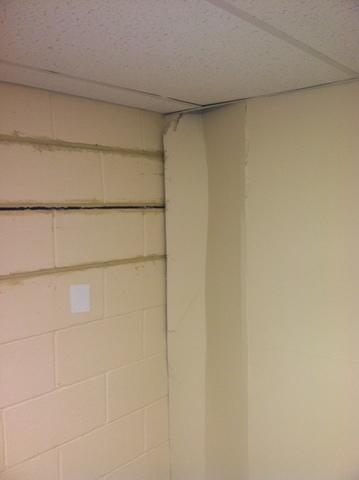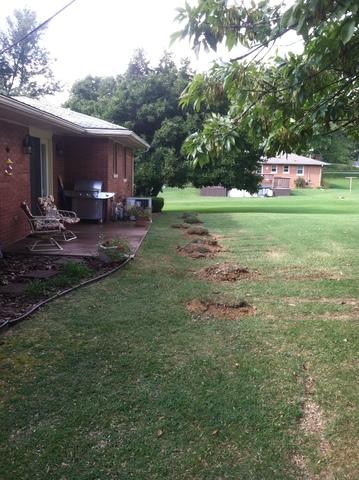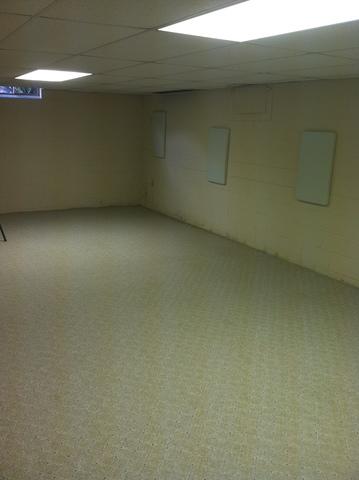
Cause of Bowing Block Wall in Vincennes
In this picture, you can see the underlying cause of the bowing basement wall in Vincennes, IN. In Vincennes, there is a significant portion of the soil that is classified as expansive to highly expansive. It's a silty clay that readily absorbs groundwater and that has created an intense pressure on the foundation walls. Those foundation walls are then forced inward much like a crushing soda can.

Close Up of Damage to Basement Wall in Vincennes
When clay soil presses against a block foundation wall, it causes the individual blocks to slide out of alignment. Over time, this makes the wall less stable and can make the home unsafe. The homeowners in this situation realized that they could not sell their home in the current condition, so they opted to repair the home before placing it on the market. The foundation repair that they opted for is called a Wall Anchor Installation and it carried nationally backed warranties that are transferrable to the new owner.

Overview of Wall Anchor Installation Site in Vincennes
Wall Anchors are solutions designed for cracked, bowing, and bucking walls. The Wall Anchor System uses anchoring plates and rods to stabilize the wall and counteract pressure being exerted against it without the cost and expense of rebuilding the entire wall. Advantages of the wall anchor system include year-round installation, minimal disturbance to lawn and landscaping, no damage to interior floor joists, the ability to straightens walls, the prevention of further bowing/leaning, and most importantly to you, it restores property value. Although failing foundation walls can be scary and intimidating, the solution of a wall anchor system can be installed quickly.

Wall Anchor Spacing for Proper Foundation Repair in Vincennes
The Wall Anchors are usually spaced 3' from the corners of the basement walls, then at 6' intervals after that. Adjustments can be made to wall anchor spacing, anchor rod length, and size of the earth anchor to ensure that the anchors will provide adequate holding capacity in almost any soil condition, or to properly reinforce horizontal cracks or work around existing pipes and electrical conduits present in the wall.

Step 1: Proper Protection of Vincennes Basement Carpet
The first step in any foundation repair project, especially a wall anchor installation is to protect the basement work environment. Here, protective plastic was been secured over the carpet to keep dust, dirt, and concrete debris from staining the carpet. Dust control is also important because foundation repair creates a lot of dust!

Step 2: Wall Anchor Plate Locations Marked for Installation in Vincennes Basement
While ideally, wall anchors are spaced 3' off the corners of basement walls and then 6' apart, the real basement stabilization has real world needs. When the technician receives their design from the engineer, they will take that plan and measure out, then mark where the anchors should be placed. However, there might be site specific conditions that become apparent that require the installation technician to notify the engineer that the anchor placement needs to be shifted slightly. In most cases, it can be as little as 3" either direction to avoid a pipe. In other cases, the anchor faceplates are low profile enough that the wall anchor can be installed directly behind the pipe without problems!

Step 3: Sod is Removed and holes dug for earth anchor placement
Outside, the sod is removed and holes are dug for the earth anchors. In some cases, the ground may need to be drilled. In others, simply hand-digging holes, called "potholes" are sufficient. The anchor is then set and we are ready to drive the anchor rods from the interior of the basement to the outside earth anchor.

Step 4: Wall Anchor Rods Driven from Basement into yard
Next, the Wall Anchor rods are driven hydraulically from the interior of the basement into the yard outside to the waiting earth anchor. Here, you can see the rod being drilled through the foundation wall into the soil outside.

Step 5: Wall Anchor Rods Hydraulically Driven into Soil to Anchor
The rod driving process takes two installation technicians, usually speaking over the phone, to give direction and guidance to make sure the rods hit the earth anchor and can be correctly tightened to provide the best stabilization for the bowing wall. You can see the drill turning through the soil.

Step 6: Wall Anchor rod attached to earth anchor for Vincennes Foundation Repair
The Wall Anchor rod is attached to the earth anchor and the earth anchor is tightened on. At this point, the system is almost complete and ready to be properly torqued according to the engineer's specifications.

Step 7: Wall Anchor Face Plates Attached to Wall in Vincennes Basement
Now, the wall anchor face plates are attached to the rod inside the basement. The faceplates are straightened and properly aligned, then the final tightening is finished up and the system is checked one last time to make sure that the wall will be stabilized and ready for seasonal tightening.

Step 8: Wall Anchors are tightened to provide stability
In the final stage of system installation, it's incredibly important to go back through and re-tighten all the faceplates one at a time. This step makes sure that each anchor is incorporated into the stabilization system and is performing as a cohesive unit.

Step 9: Wall Anchors will Gradually Tighten Bowed Wall while repairing foundation stability
Wall anchors can be tightened periodically throughout dry seasons to slowly pull wall back to a straight position. Healthy Spaces installed Geo-Lock Wall Anchors that are tightened to a specific amount of torque that is easily measured and correlates to a force that is easily handled by the strength of the wall and the passive resistance of the soil on the outside of the wall (or backfill soils). Between the torque and the force of the walls, the engineered wall anchors are calculated to allow for seasonal tightening. This occurs because the soils dry out slightly and place less resistance force on the wall from behind. The decrease in resistance allows the anchors to be tightened. The tightening procedure brings the overall torque back to the installed torque and the system remains stable. In essence, the wall anchor tightening procedure is actually better for the wall than leaving the system alone would be!

Overview of Installed Wall Anchor Covers
Wall anchor covers are a fantastic addition to the Geo-lock Wall Anchor system because they allow homeowners to remove the cover easily and tighten the system seasonally. These covers can be inset into drywall, or left over top of a block wall as pictured here.

Foundation Repair in Vincennes Basement
Here's the finished project! The site is cleaned properly and ready to go. The homeowners are then educated on how to properly tighten the system and left with tightening instructions and the proper tools. Now, over the next few years, the wall will gradually be returned to a straight and proper condition.
